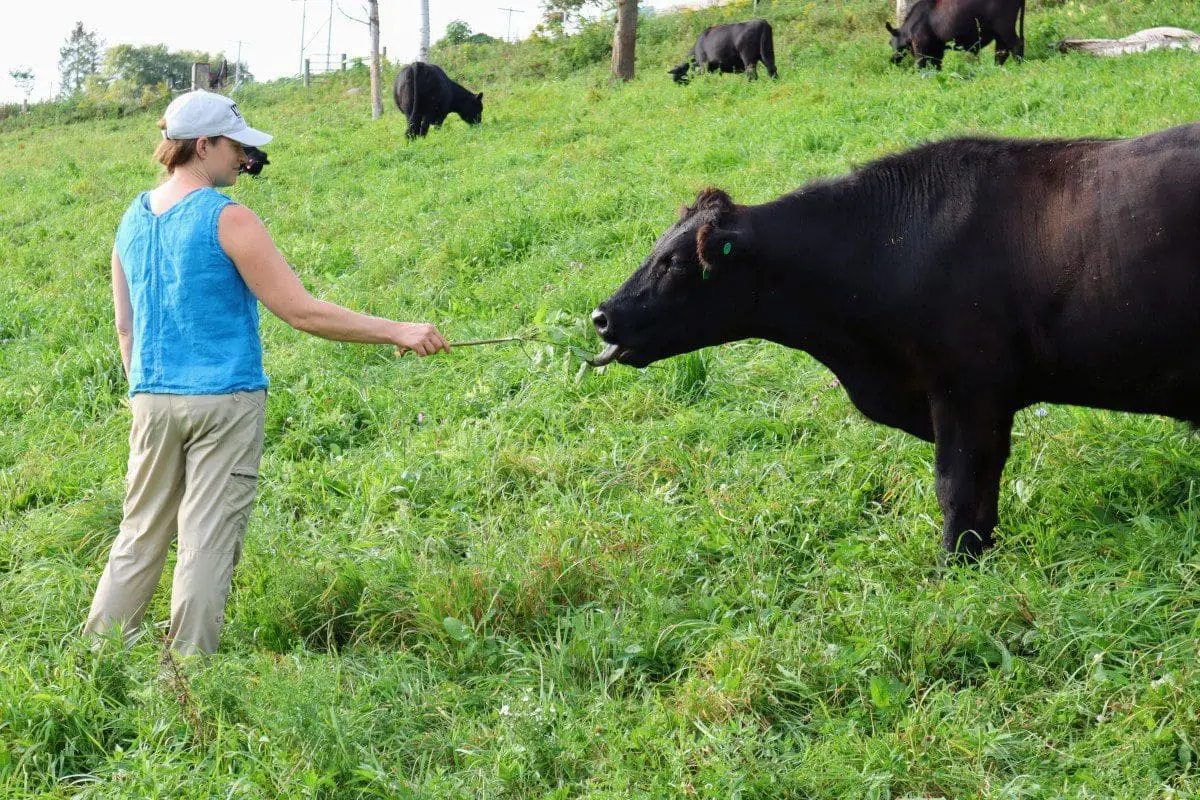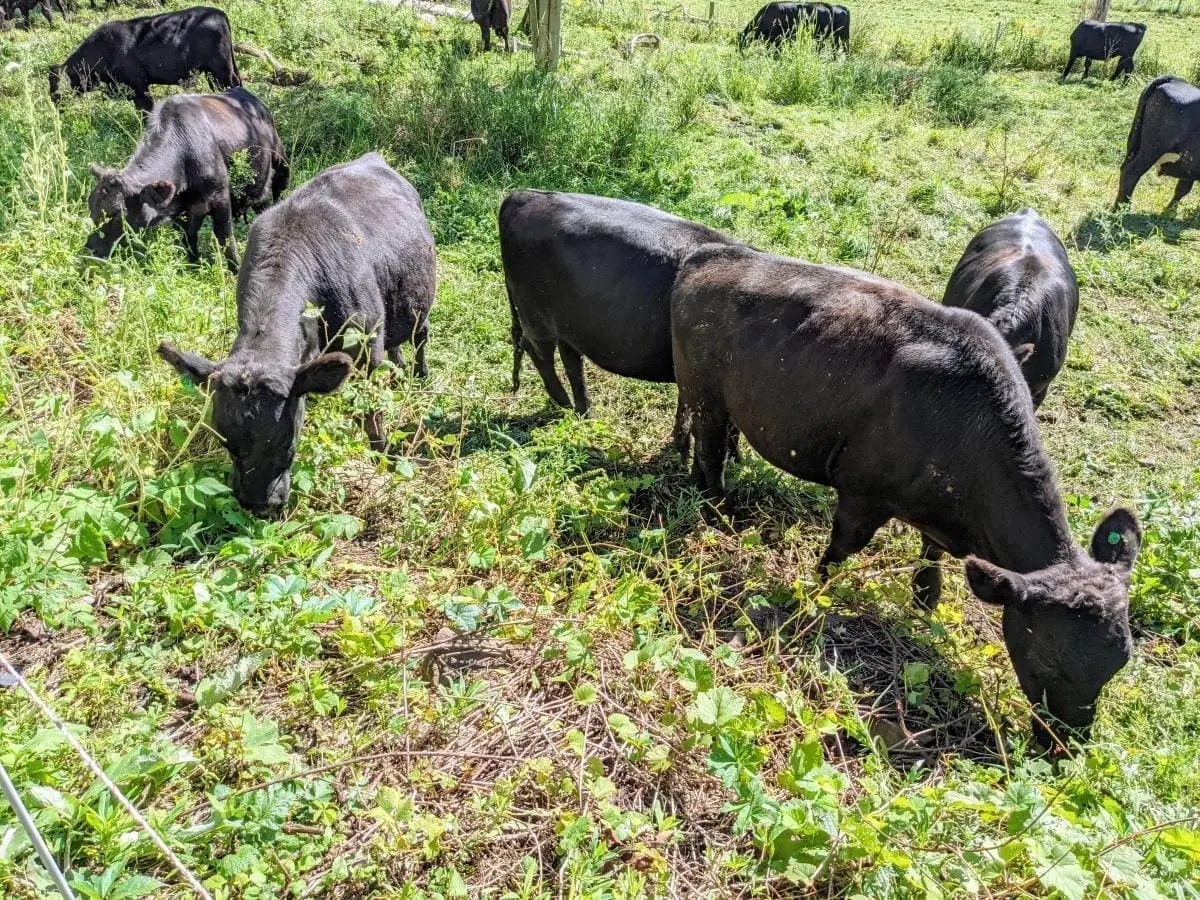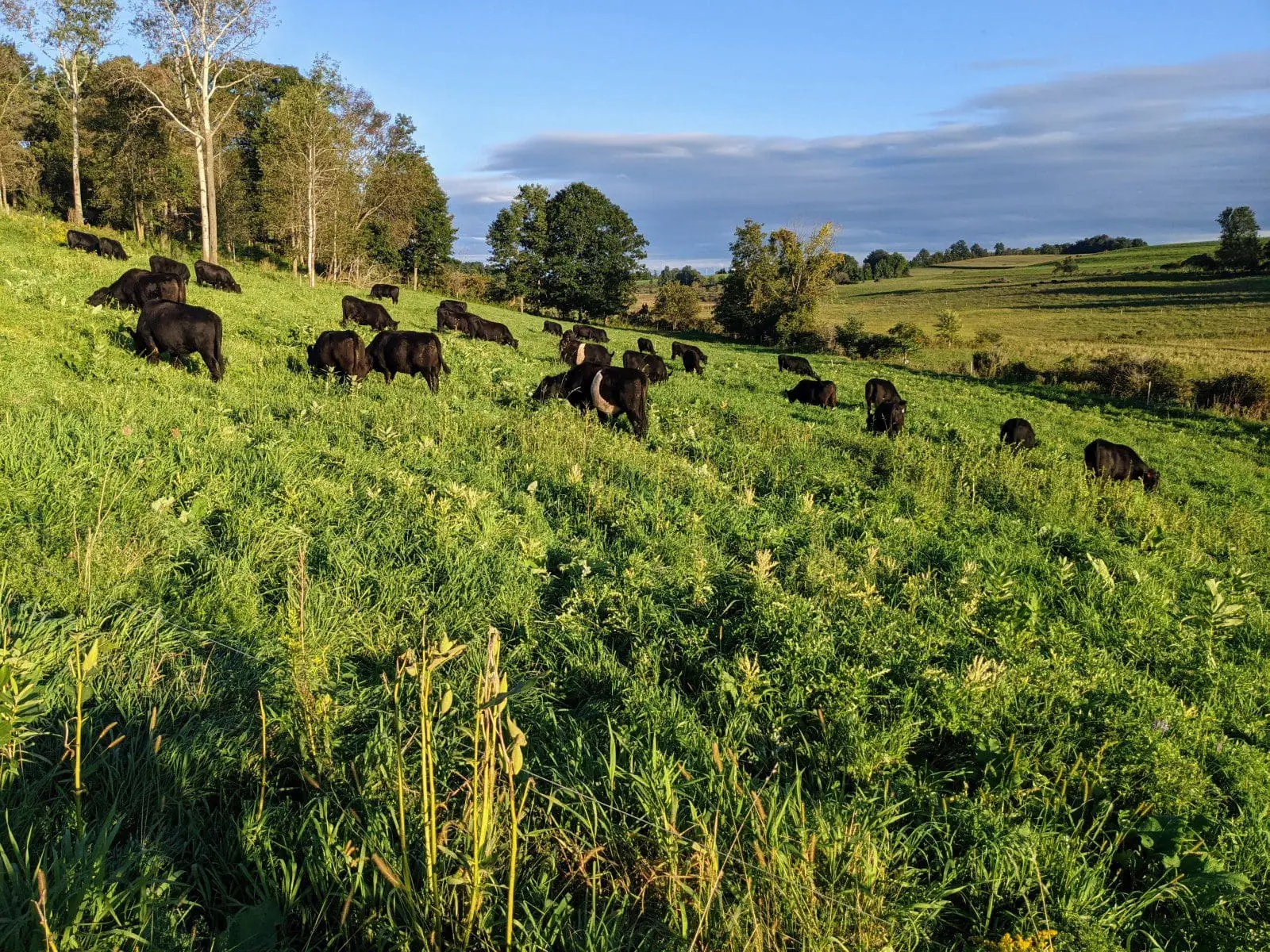When we talk about grass fed, grass finished beef, obviously the word “grass” gets a lot of prominence. So grass and grass only, right? The answer isn’t so clean cut. As with a lot of things, the name of the practice is perhaps not the best choice. It isn’t deliberately misleading, but it doesn’t tell the whole story.
Instead of grass, maybe we should be talking about Leaf Fed/Leaf Finished. Or Grass+ Fed. That’s because this isn’t about being limited by the exclusivity of the grass category. This is more about providing cattle the best possible diet, one that consists of all kinds of leaves that fit within our pasture ecosystem.
Leaf Fed Beef
When I look at our pastures, I count about seven main types of grasses. Bluegrass, brome grass, fescue, orchard grass, reed canarygrass, perennial ryegrass, timothy.
But I can think of a far greater array of plants that also grow in our fields, and none of them are technically grasses. Some are legumes (red, white, and sweet clover, alfalfa, vetch, birdsfoot trefoil), some are deep rooted biennials (burdock, parsnip, wild carrot), some are perennial shrubs (elderberry, shrub willow, wild black raspberry). And then we can look at the trees with edible leaves (apple, poplar, sumac, willow) and the wild grape vines tangled through them. I started making a list of plants the cattle graze here, and after forty entries I realized I was only part way there.
For the cattle in our pastures, yes, it is true that grasses make up the greatest portion of their intake. But talking only about grasses misses leaves out some of the best parts of the story we can be telling. Our leaf fed cattle experience an abundant, varied, and complex diet. Having all these food options gives them an optimally balanced diet as different plants change their nutritional profiles throughout the year. Some plants are medicinal (like the echinacea and broadleaf plantain growing in the fields), some help with parasites (willow), some contain essential minerals drawn by deep tap roots (tree leaves). Each plant fits into an important place in the nutritional puzzle.

What’s the Big Deal About Eating Leaves?
The big deal is that cattle can graze an abundant, indefinitely renewable, and locally available resource. Here in Upstate New York we can produce a lot of greenery. Our growing seasons are consistently wet and our summer days are long. We grow more than enough to feed cattle all through the green season. And we still have plenty of extra grass to bale up during the summer to feed the cattle during the winter.
So when we talk about grass fed beef, or leaf fed beef if you will, we’re talking about one of the most responsible ways to produce high quality food per acre. We can grow top quality cattle forage on land like our farm, land that isn’t suitable for crops. I’m always amazed standing in the field with my cattle, thinking about the transformation going on every day all around me.

So What Can’t Grass Fed Cattle Eat?
The only hard line here is about saying no to grain and grain byproducts. Even though grains come from plants within the larger grass family, their grain seeds are something cattle would never have encountered in nature. Feeding cattle grain upsets their gut microbiome, since metabolizing grain starches tilts their rumen pH toward acidity. Animals like chickens and pigs naturally have acidic stomachs, so they can thrive on grains. But cattle have a very different digestive system, one that is optimized for the digestion of huge quantities of coarse, high-fiber plant roughage. Grain feeding, especially in the concentrations used in commercial farming, leads to acidosis. Once the cattle are in ill health, they require more frequent interventions with pharmaceuticals like antibiotics and ionophores. The whole system of grain feeding slides the cattle toward compromised health in order to quickly add pounds.
Grass Fed isn’t about Exclusion. It’s about Abundance.
But even in making the statement that our grass fed cattle are never fed grain, I’d like to point out a more fundamental idea. Our focus as farmers should be to maximize abundance. Contemporary conventional agriculture orients farmers toward focusing on negatives: fighting weeds, killing pests, medicating disease, fixing machines, and tolerating low prices.
In telling the story of grass fed, leaf fed beef, I don’t want to spend much time arguing against grain feeding. Focusing on the negative (“we don’t feed grain”) tells part of the story, but it doesn’t adequately highlight the goodness of the positive (“cattle eat a wide variety of green leaves that provide them everything they need”). Grass fed is good because it is a system based on recycling leaves and plants. These are abundant, renewable feed resources, and these animals are uniquely well suited for consuming them.
When we talk about both animal nutrition and human nutrition, it seems easier to lapse into obsession over the evils and dangers, and thus to miss out on all the great options we have available before us. And all the marketing bombarding us works diligently to keep us in a state of worry, primed for the next sales pitch for something to help us battle a problem.
Accentuate the Positive
I want to farm for abundance. I can’t ignore weeds, pests, and the rest, but I want to focus on promoting the sources of excellence on our farm. What practices make the most grasses and forage plants grow on our farm? Let’s find them and outcompete the weeds. Which plants make our cattle the healthiest? Let’s feed those and avoid the need to medicate. That’s the idea.
Grass fed beef really shines when we look at food production from a positive, abundance orientation. We can look for what is good and use that to anchor everything we’re accomplishing here. Our cattle are grazing a completely renewable resource that we can’t eat ourselves. They convert it into high quality nutrition using only the resources that come from the farm. Over time, because of their synergistic relationship with these plants they improve the soil and the quality of the plants, leading to yet more abundance. This is an amazing system!
Our goal as farmers, especially those of us on the organic/regenerative side of farming, is to be abundance-workers. How can we take the sunshine, water, soil, plant, and animal resources and use them to create more abundance? Surely this is a better use of our time, and a more satisfying way of living, than just focusing on all the thing we aren’t doing.
If you are reading this not as a farmer but as a consumer, I’d challenge you to find ways to be an abundance-consumer. If you have the privilege of choosing what you buy and what you eat, can you find food that comes from a place of abundance? The mainstream market focuses on negatives, like cost-cutting and competition-squashing. Surely we can all do better than that. Let’s all support those who are doing the work of creating something better.

So are our cattle grass fed and grass finished? Yes, we meet the grazing standards of every organization that has ever tried to standardize the definition. But we’d rather be known for abundant leaf fed cattle.
